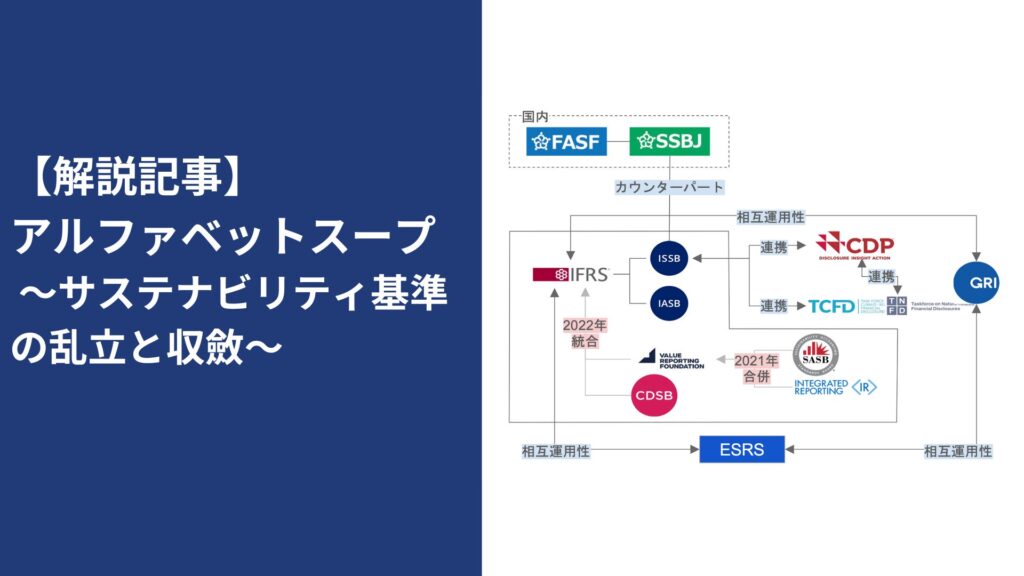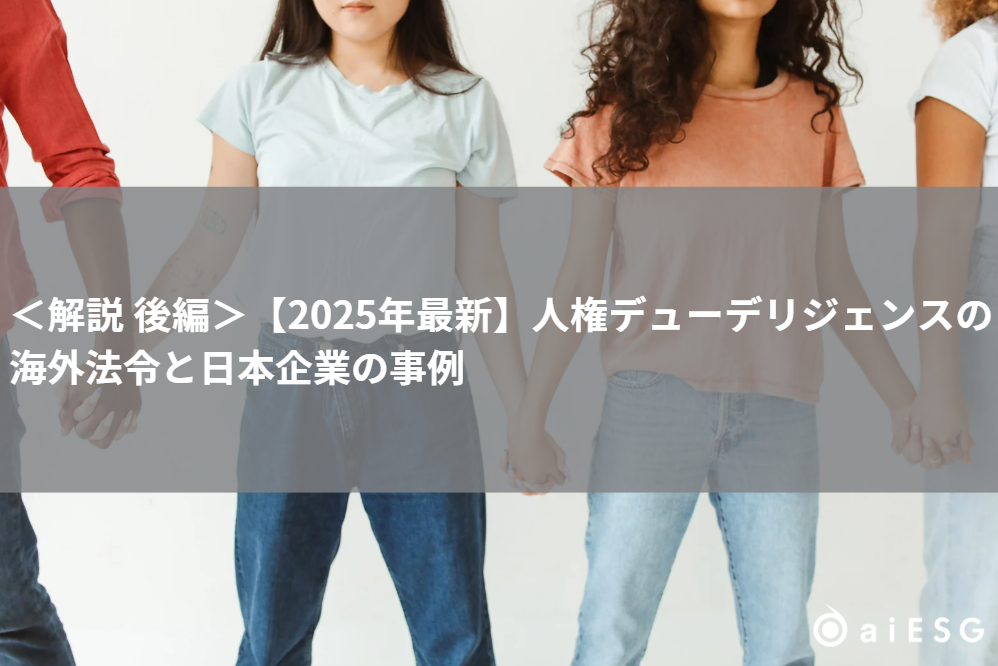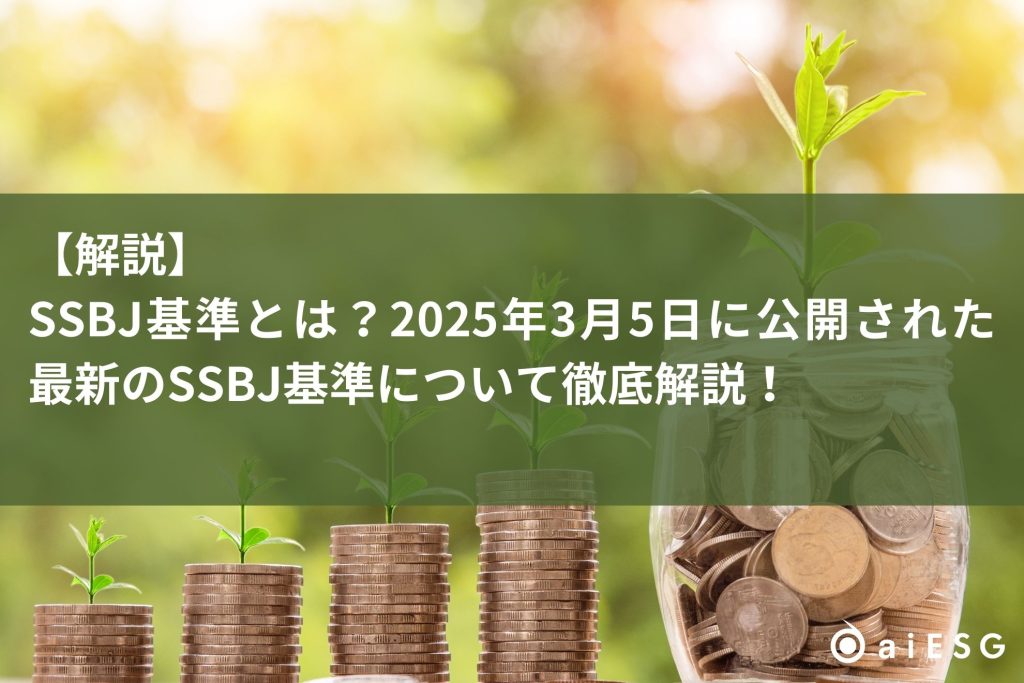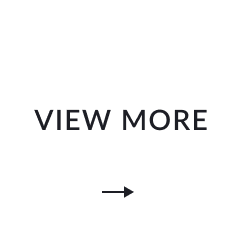INDEX
In recent years, along with the growing interest in disclosing non-financial information, such as environmental, social, and human capital information, there has been intense activity surrounding related frameworks and standards. For companies, the need to not only identify their own risks and opportunities, but also to choose the appropriate method of information disclosure, leads to an increased disclosure burden. For investors, there are also significant costs associated with referencing and comparing various standards.
This article will present an overview of these standards and regulations once again and the movement toward unification.
Table of Contents
Alphabet soup of disclosure standards
Elements characterizing the criteria
Movement toward Unification
1. joint statement by five non-financial standard-setting organizations
2. establishment of ISSB
Sustainability Reporting Standards in Europe
Establishment of ISSB and relationship between each standard
SSBJ: Domestic standard corresponding to ISSB
aiESG and SASB Standard License
Conclusion
Alphabet soup of disclosure standards and rules
The term "alphabet soup" is a figurative expression used to describe the abundance of abbreviations and acronyms. It has come to be used to refer to non-financial information-related situations due to the heavy use of alphabets in sustainability and ESG-related frameworks and standards. The main frameworks and standards that have been published to date are summarized below.
Table 1 : Major ESG-related frameworks and standards
| name | summary |
| CDP Questionnaire | Environmental Questionnaire] CDP Questionnaire sent to companies and scoring on environmental risks/opportunities based on responses. |
| UN Principles for Responsible Investment (PRI) | ESG Reporting Obligations: Signatory institutions are required to submit a report every year and are expelled if they fail to meet the standards. |
| GRI Standards | Disclosure Framework: Criteria for the disclosure of information about an organization's economic, environmental, and social impact to multiple stakeholders. |
| IIRC Framework | [Disclosure Framework (Principle-Based)] A framework for improving the quality of information available to providers of financial capital through the preparation of annual integrated reports and for more effective and productive allocation of capital. |
| SASB Standard | Disclosure Framework (Individual Rules): Criteria for companies to disclose information on sustainability risks and opportunities to investors. |
| CDSB Framework | Framework for Disclosure of Climate-related Information] Standards for disclosing environmental and climate-related information to investors in a company's mainstream reports. |
| TCFDinterpoint (interword separation)TNFD | Framework for Disclosure of Climate, Nature, and Biodiversity-Related Information] Criteria for disclosing climate- and nature-related information with financial implications in annual financial reports. |
| CSRD | EU: Corporate Sustainability Reporting Directive Sustainability Reporting Standard adopted in 2022 EU countries are required to make it mandatory through national legislation |
| ESRS | EU: European Sustainability Reporting Standards A statement of standards that provides specific items for disclosure in the CSRD |
| CSDDD (CS3D) Proposal | EU: Draft Corporate Sustainability Due Diligence Directive Draft Directive establishing corporate duty of care and mitigation of human rights and environmental impacts |
| SFDR | EU: Sustainable Finance Disclosure Rules Disclosure rules promulgated in 2019 for financial market participants to improve transparency regarding sustainability information |
Explanatory reports on some of these criteria are available on this website.
interpoint (interword separation)What is the SASB Standard for ESG Disclosure? (Part 1)SASB Outline | aiESG
interpoint (interword separation)What is the SASB Standard for ESG Disclosure? (Part 2) Benefits for Companies | aiESG
interpoint (interword separation)What is TNFD? A New Bridge between Finance and the Natural Environment | aiESG
interpoint (interword separation)CSRD: The EU Sustainability Reporting Standard Just Before It Enters into Force ~Implications for Japanese Companies~ | aiESG
interpoint (interword separation)ESRS (European Sustainability Reporting Standards) | aiESG
interpoint (interword separation)SFDR: What is the EU Sustainable Finance Disclosure Regulation? ~ ESG-related disclosure requirements for financial instruments~ | aiESG
In addition to these, there are numerous national standards committees and other organizations. Companies have been required to understand the characteristics of each standard, and to choose which standard to follow or to comply with multiple standards.
Elements characterizing the criteria
Disclosure standards and frameworks have unique characteristics and are not necessarily substitutable. Factors that compare them include subject areas, principle or bylaw principles, intended users, and types of materiality.
For example, while there are standards that include all ESG (environmental, social, and governance) as the subject of disclosure, there are also frameworks that focus specifically on the environment, such as the TCFD. The principle-based IIRC framework, which does not set standards for individual indicators, and the SASB, which provides detailed information on specific disclosure items, can be considered complementary to each other [1]. Other disclosure items can be characterized from multiple perspectives depending on whether the main disclosure targets are investors or multistakeholders, and whether double materiality, which considers the impact of corporate activities on the environment and society in addition to the impact of environmental and social impacts on the company, is adopted.
According to a survey by Sherman & Sterling, 85 of the 100 largest companies in the U.S. have published CSR reports that comply with multiple standards, with 38 of those companies complying with GRI, SASB, TCFD, and the UN Principles [2].
The situation where no one indicator is predominant and each has its own background and defenses is one of the factors that have made the alphabet soup of disclosure standards so complex.
Movement toward Unification
The proliferation of ESG-related standards has led to calls for uniformity from both companies and investors.
Of the criteria mentioned in the opening table, several organizations have already merged or consolidated. Some of the major events toward unification include the following
1. joint statement by five non-financial standard-setting organizations[3]
In September 2020, CDP, CDSB, GRI, IIRC, and SASB announced their cooperation for a comprehensive corporate disclosure system through a statement. After this, the various organizations, which had been operating separately, will accelerate their movement toward unification.
2. establishment of ISSB
It is a sub-organization of the IFRS Foundation, established in November 2021, which is working to develop a uniform disclosure standard consistent with a number of standards and frameworks. This article focuses on.
Sustainability Reporting Standards in Europe
The CSRD (Corporate Sustainability Reporting Directive) and ESRS (European Sustainability Reporting Standard) have established uniform reporting standards for all large companies in the EU and for all companies except micro enterprises listed on EU regulated markets. It is also harmonized with the above ISSB.
Establishment of ISSB and relationship between each standard
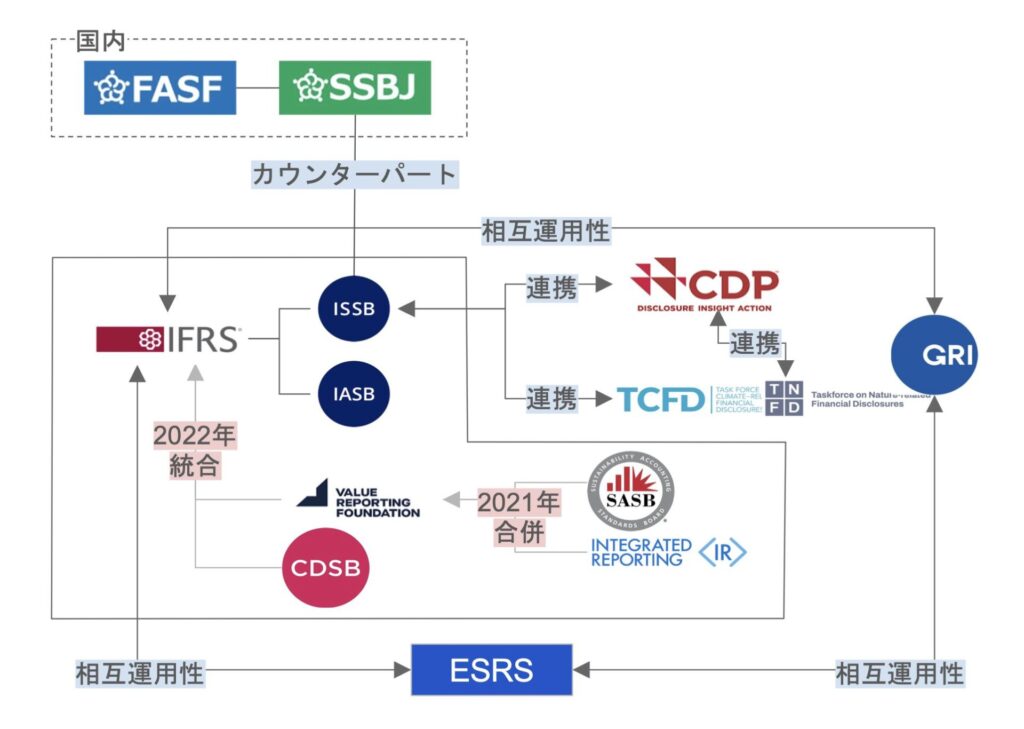
Figure 1: IFRS Foundation and Surrounding Standards (Prepared by Author)
One centerpiece of the movement toward alphabet soup convergence is the IFRS (International Financial Reporting Standards) Foundation. In response to market demands for integration of disclosure rules, a new standards board, the International Sustainability Standards Board (ISSB), was established in November 2021 as a subordinate body of the IFRS Foundation. Its composition and specifics are described in detail in the following article.
Commentary] ISSB ~Global Baseline for Sustainability Disclosure~ | aiESG
Around the time of the launch of the ISSB, various organizations announced their collaboration and cooperation with the IFRS Foundation: the IIRC and SASB[4], which merged to form the Value Reporting Foundation (VRF) in 2021, were integrated into the IFRS Foundation the following year in 2022[5]. Prior to that, CDSB was also integrated into IFRS [6]. GRI and CDP have also each announced cooperation with the ISSB[7][8], resulting in all five organizations announcing joint statements in 2020 having ties to the ISSB (Table 2).
In addition, interoperability of the ISSB with European disclosure standards has been discussed [9]. The European Commission has been promoting mandatory corporate sustainability reporting through the CSRD and its subordinate ESRS, and has been reconciling inconsistencies such as differences in the scope of ESG matters between these reporting standards and the ISSB standards. A guidance text will be prepared to assist companies applying both standards.
The final version of the ISSB standard [10], published in June 2023, establishes specific disclosure requirements for each industry based on the TCFD framework and the SASB. The ISSB aims to be a "good-guy" format that draws on existing frameworks, rather than creating new standards from scratch. This is expected to facilitate the intention of companies that already disclose information in accordance with other frameworks to join the ISSB, and to spread the use of the ISSB as a mutually comparable ESG report.
Table 2: Movement toward unification around IFRS
| counter for years (following a number in the hito-futa-mi counting system) | trend |
| September 2020 | Joint statement by five non-financial standard setting organizations (CDP, CDSB, GRI, IIRC, SASB) |
| June 2021 | IIRC and SASB merge to form VRF |
| July 2021 | EFRAG (ESRS) and GRI signed MoU[11]. |
| November 2021 | Inauguration of ISSB |
| January 2022 | CDSB integrated into IFRS |
| March 2022 | IFRS and GRI Sign MoU |
| August 2022 | VRF integrated into IFRS |
| November 2022 | CDP announces incorporation of ISSB climate change disclosure standards (from 2024) |
| June 2023 | ISSB publishes first standards S1 and S2 |
| July 2023 | ISSB to take over TCFD monitoring responsibilities starting in 2024[12]. |
| July 2023 | ISSB and ESRS Interoperability Announced |
| September 2023 | CDP expressed its intention to align with the TNFD framework[13]. |
SSBJ: Domestic standard corresponding to ISSB
Following the establishment of the ISSBB by the IFRS Foundation, the Sustainability Standards Board Japan (SSBJ) was created as a domestic counterpart to the FASF (Financial Accounting Standards Foundation) in July 2022 to develop domestic standards for sustainability disclosure and to provide input to the ISSBB (Figure 2). SSBJ was established in July 2022 as an internal organization of the FASF (Financial Accounting Standards Board) (Figure 2).

Figure 2: Correspondence between the IFRS Foundation and the FASF (Sustainability Standards Board Japan (SSBJ))
The SSBJ is currently in the process of developing a Japanese version of the ISSB disclosure standards based on IFRS S1 and IFRS S2, with plans to publish a finalized standard during fiscal 2024 and to begin early adoption in the following fiscal year[14].
aiESG and SASB Standard License
With the convergence of disparate standards and frameworks now in sight, an increasing number of companies are considering new non-financial disclosure initiatives or preparing reports in compliance with ISSB standards. However, many companies find it burdensome to collect and organize the information required to meet the detailed disclosure rules, and to research back through the supply chain. It is also difficult to determine what type of analysis is required to be considered compliant and to what extent.
In August 2023, aiESG obtained a "Corporate Reporting Software" Licence under the SASB standard, which is the basis for the individual provisions of the ISSB [15]. This is the first acquisition for a company headquartered in Japan and the world's first ESG assessment at the product and service level.
This enables us to deliver more reliable and transparent information for corporate ESG compliance.
Through AI analysis using proprietary supply chain big data, aiESG calculates more than 3,200 ESG indicators that can be traced back through the supply chain [16]. These items cover not only indicators such as greenhouse gas emissions, which can be measured by conventional services, but also a wide range of other indicators such as wages, child labor, gender equality (closing the gender gap), and consumption of water and mineral resources (Figure 3).
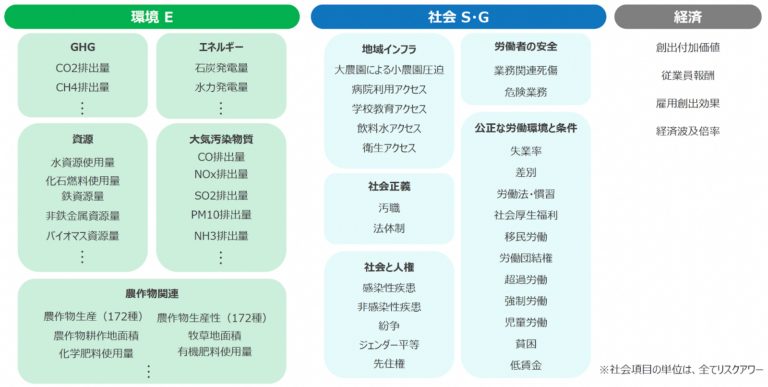
Figure 3: List of aiESG evaluation items (excerpt)
In addition, only product cost structure data or physical quantity data is required for analysis, greatly reducing the effort required for information disclosure.
As a SASB license holder, aiESG's services provide reliable support for compliance with the evolving ISSB standards, which encompass many standards.
Conclusion
In the move toward alphabet soup convergence, the ISSB has attracted much anticipation and attention as a global baseline involving many existing standards. Furthermore, with the announcement of interoperability with the European disclosure standard, the ESRS, its importance is likely to increase further in the future. We will continue to closely monitor the trend of international ESG information disclosure and initiate early discussions toward information disclosure required by investors and society, which will lead to opportunities for companies to reduce the risk of loss and achieve further growth.
aiESG provides support from basic ESG-related standards and frameworks to actual disclosure of non-financial information, so please contact us if you have any ESG-related issues.
Contact us:
https://aiesg.co.jp/contact/
Bibliography
[1] 001_05_00.pdf (meti.go.jp)
[2] Corporate Governance - Corporate Governance and Exec Compensation 2021 (shearman.com)
[3] Statement of Intent to Work Together Towards Comprehensive Corporate Reporting | Integrated Reporting
[4] Home - The Value Reporting Foundation
[5] IFRS - IFRS Foundation completes consolidation with Value Reporting Foundation
[6] IFRS - IFRS Foundation completes consolidation of CDSB from CDP
[7] IFRS - IFRS Foundation and GRI to align capital market and multi-stakeholder standards to create an interconnected approach for sustainability disclosures
[8] IFRS - ISSB at COP27: CDP to incorporate ISSB Climate-related Disclosures Standard into global environmental disclosure platform
[9] IFRS - European Commission, EFRAG and ISSB confirm high degree of climate-disclosure alignment
[10] IFRS - IFRS Sustainability Standards Navigator
[11] GRI - GRI welcomes role as 'co-constructor' of new EU sustainability reporting standards (globalreporting. org)
[12] IFRS - IFRS Foundation welcomes culmination of TCFD work and transfer of TCFD monitoring responsibilities to ISSB from 2024
[13] CDP announces intention to align with TNFD framework and drive implementation across global economy - CDP
[14] 2023_0803_ssbj.pdf (asb.or.jp)
[15] SASB - ESG Integration - Standardized Data Architecture
[16] Part 2: What services does aiESG provide | aiESG
Related page
Report List : Regulations/Standards
https://aiesg.co.jp/topics/report/tag/基準-規制/
【【Explanation] What is TNFD? A new bridge between finance and the natural environment
https://aiesg.co.jp/topics/report/230913_tnfdreport/
What is the SASB Standard for ESG Information Disclosure? (Part 1)Outline of SASB
https://aiesg.co.jp/topics/report/2301025_sasb1/
CSRD: The EU version of the sustainability reporting standard just before it comes into effect
~Impact on Japanese companies
https://aiesg.co.jp/topics/report/2301120_csrd/
SFDR: What are the EU Sustainable Finance Disclosure Rules?
~ESG-related information disclosure obligations for financial products~
https://aiesg.co.jp/topics/report/2301222_sfdr/

